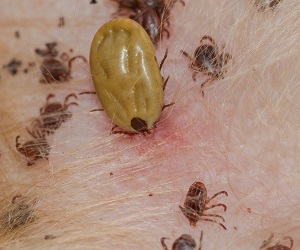A dog is definitely man's best friend. And, in today's day and time there are so many places you can take your furry friend along with you to enjoy their company. While walks or travels with your dog can be quite enjoyable, you may find yourself worrying about ticks and other insects.
Managing your dog's coat health and ensuring that they aren't being bitten by pests or other insects is easy if you know how to go about it. Here's all you need to know about this to help you take care of your furry friend.
Where to Look for Ticks?
Ticks are pests that are more drawn to dogs than humans, it is important to check your dog's coat often especially when they enter home after their walk outside to ensure they aren't tick-ridden.
If your furry friend has play dates in the forest, spends a lot of time in your backyard or outside your home or travels often with you, it would be best to check them for fleas every day. And, is best done when they just come back home inside from the outside. To do this, look under and around their collar, near or inside their ears, around their eyes, between their toes and around their tail.
How to Know if Your Dog has Tick Disease?
While you try to keep pests and insects away from your dog, it is possible for them to contract tick diseases like Lyme disease, Rocky Mountain Spotted Fever, and Anaplasmosis. In such cases, early detection can help you save your pet's life. If your furry friend does contact any of these diseases, make sure you alert their vet as soon as possible.
Here is what you need to look out for:
- Fever
- Reduced appetite
- Lethargy
- Limping or pain in joints
- Swelling in lymph nodes
Remember, it can be difficult to spot these symptoms as they tend to show only after one or three weeks.
Removing Ticks from Your Furry Friend's Coat
 Removing any pest or insect that may have caught on to your dog's coat can help you prevent pathogens from being transmitted to them. To do this, first ensure your hands are clean and washed. Then, take a tweezer and get a good grip on the flea. Remember to grip the part of it closest to your dog's skin. Now, pull the flea away without twisting or turning your tweezers.
Removing any pest or insect that may have caught on to your dog's coat can help you prevent pathogens from being transmitted to them. To do this, first ensure your hands are clean and washed. Then, take a tweezer and get a good grip on the flea. Remember to grip the part of it closest to your dog's skin. Now, pull the flea away without twisting or turning your tweezers.
Instead of crushing the flea, dispose of it by wrapping it in tape, flushing it down the toilet or drowning it in alcohol. It would be wise to ask your vet for advice to keep these little pests away from your pet and your property. If you notice that your pet is often bitten by or attacked by these little creatures, consider asking your vet for a product that acts as a solution for the same.
Kinds of Ticks
Ticks feed on your pet's blood and so knowing enough about them to keep them away certainly helps keep your dog safe. The different kinds of ticks that can feed on your dog are:
- Brown Dog Ticks - When a tick hasn't fed, it is about 1/8" long and is about t 1/2" after it feeds. These kinds of ticks are a reddish-brown with certain portions that become olive or gray-blue once it has fed.
- American Dog Tick - These brown little creatures have white or gray marks. Female ones that have not fed yet are about 3/16" long and become 5/8" long after feeding. They are brown but have white to gray marks.
- Deer Tick (black-legged) - These have orange brown bodies and become darker on their abdomen after they feed. The females that haven't fed are about 1/8" long.
- Lone Star Tick - These reddish brown ones become gray in color after they feed. The full grown female ones are as long as 1/8" and become 7/16" after feeding.
Keep These Pests Away!
Remember that fleas can be quite pesky and can cause your pet to have many health issues if they aren't removed in time. So, it is important to remove them and contact your vet as soon as you spot them.
In case your pet has a recurring problem with ticks, it could be possible that your property or home is infested with pests including fleas that easily catch on to your furry friend's coat when they go outside. In such cases, consult the experts at Protech Pest Control to get your property treated for pests and restore it to being a healthy home for your pet again.